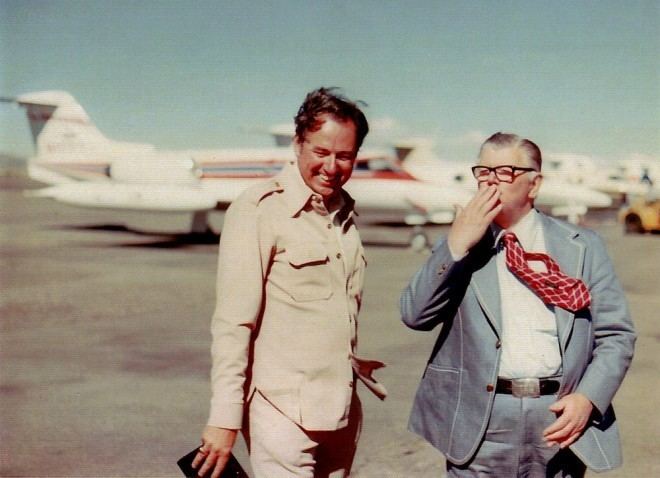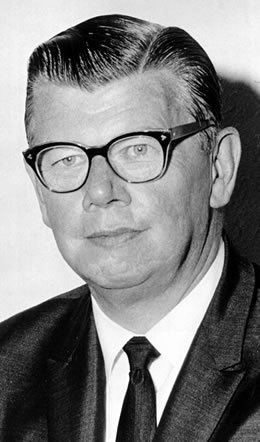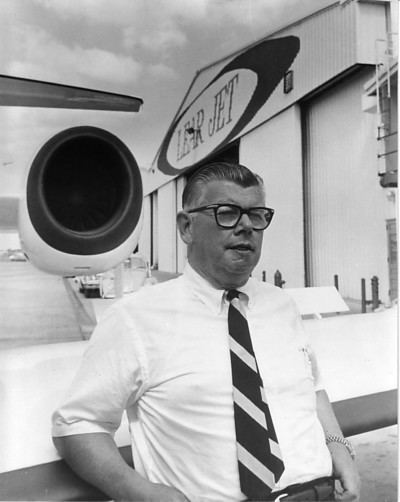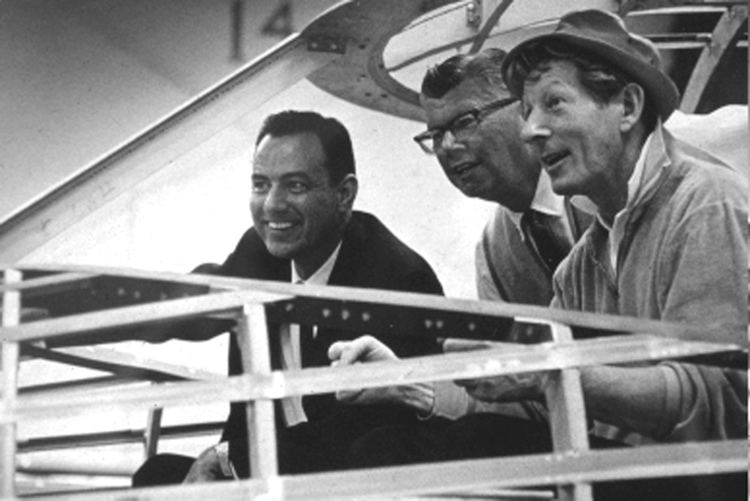Cause of death Leukemia Known for car radio, Lear Jet Nationality American Name Bill Lear | Occupation Engineer, Inventor Role Inventor | |
 | ||
Children Mary Louise, William, Jr., Patti, John, Shanda, David, and Tina Spouse Madeline Lear (m. 1926), Margret Radell, Ethel Lear Education Central High School, Moody Bible Institute | ||
Inventor of the Lear Jet Remembering Bill Lear
William Powell "Bill" Lear (June 26, 1902 – May 14, 1978) was an American inventor and businessman. He is best known for founding the Lear Jet Corporation, a manufacturer of business jets. He also invented the battery eliminator for the B battery, and developed the 8-track cartridge, an audio tape system. Throughout his career of 46 years, Lear received over 120 patents.
Contents
- Inventor of the Lear Jet Remembering Bill Lear
- Bill lear one on the mountain stage 2010 lemars country music festival
- Early life
- Radio engineer
- Music cartridges
- Transportation
- Aviation
- Personal life
- Tributes and honors
- Learisms
- References

Bill lear one on the mountain stage 2010 lemars country music festival
Early life

Lear was born on June 26, 1902 in Hannibal, Missouri to Ruben Marion Lear, a carpenter, and Gertrude Elizabeth Powell Lear. Ruben was a man who had "success in inverse proportion to effort", so Lear's mother left him; mother and son stayed with aunt Gussie Bornhouser in Dubuque, Iowa. Later Otto Kirmse took them in and was a step-father to Bill Lear. The family relocated to Chicago where Lear attended Kershaw Grammar School. On Sundays, young Lear attended the Moody Tabernacle (now Moody Church). "From listening to Paul Rader, of the Moody Tabernacle, he learned grammar and how to speak. He found out how to meet people, how to shake hands, and what to say when he did so... He learned about hypocrisy, too" and ceased any further church affiliation.

Lear entered Englewood High School but was dismissed for showing up teachers. He worked for the Multigraph Company, running and repairing rotary typesetting and printing machines. While in Chicago, Lear had also been employed briefly at a local air field. One summer he spent with his father in Tulsa, re-building a Model-T car. Too independent to move back with his mother in Chicago, Lear struck out cross country. He joined the U.S. Navy and was sent to Great Lakes Naval Training Station. Later after discharge, and with a young family, "he decided to complete his high school education. Starting a radio repair shop in his home, which he could tend nights, Lear enrolled at Tulsa Central High School, taking eight solids, heavy on the math. He was at the point of wrapping up the entire four-year curriculum in one when he was again dismissed for showing up teachers."
Radio engineer

Lear was self-taught: "He had read widely on wireless, including the works of Nikola Tesla, the scientist/inventor. He had even built a radio set, based on a twenty-five-cent Galena crystal which he sent away for, and he had learned the Morse code, the fun ending with the ban on radio during World War I."

One of his first ventures was with Lawrence Sorensen, selling loose radio couplers. Lear had been an "instructor in wireless" in the U.S. Navy so he confidently identified himself as a radio engineer to Clifford Reid in Quincy, Illinois. Reid was selling auto supplies and hired Lear to expand into radio. With contractor Julius Bergen, he founded Quincy Radio Labs and built speaker boxes for radios. Lear also helped develop WLAL which evolved into the powerful station KVOO.
Lear’s talents as engineer showed in 1924 when he moved to Chicago and built a B-battery eliminator for the Universal Battery Company with R. D. Morey. Then he met Waldorf Astoria Smith of the Carter Radio Company who helped him with radio theory including Ohm's law. Tom Fletcher of the QRS Company was so impressed by Lear’s radio set designed around a QRS rectifier tube that he hired him, offering 60% more pay than Universal Battery. Bill Grunow of the Grigsby-Grunow-Hinds Company topped that offer when Lear fixed the problem with 60,000 B-battery eliminators that they had manufactured. Lear also came up with an invention in 1924 when power inverters installed at Stevens Hotel failed to perform for the Radio Manufacturers’ Association.
Lear built audio amplifiers and cases for the Magnavox speakers then coming out. The Magnavox "majestic dynamic speakers" that he produced with Grunow were very popular. With Ernie Tyrman he built and sold radio sets, using methods patented by others, which they had not licensed. Anxious over prosecution for patent infringement, they both developed ulcers. Tyrman died after surgery; consequently, Lear changed his diet.
Lear Radio Laboratories was the source of an early step to miniaturization in electronics. Tuning coils in the radio frequency stage of a set were rather large and Lear knew how to reduce their size by using Litz wire. Wire braided from many fine strands has a large surface area giving it high conductivity at radio frequency. Lear borrowed $5,000 from his friend Algot Olson to make machines to wrap the strands, braid the wire, and wind the coils. The industry was set up in the basement of his mother’s old house on 65th street, and done with assistance of Don Mitchell, a railroad electrician. Lear called the company Radio Coil and Wire Corporation. They took an order of 50,000 coils from Eugene F. McDonald of Zenith Electronics when they demonstrated them. These small coils were one-quarter the size of coils with solid wire.
Lear traded his Radio Coil business for a one-third interest in Paul Galvin's Galvin Manufacturing Company. At that time the radio had not yet been developed for use in automobiles, but Lear and Howard Gates of Zenith made a pair; Lear designed the circuit and layout, Gates did the metal work and Lear assembled them. When Lear presented Galvin with the prototype, it was first dismissed. Later the idea was surfaced by Galvin and a 200-unit production run was made. Galvin and Lear mulled over names for the product on a cross-country trip and came up with "Motorola" which was a blend of "motor" and the then popular suffix -ola used with audio equipment of the time (for example "Victrola"). The product was such a success that Galvin changed the name of the company to Motorola.
Music cartridges
Lear developed the Lear Jet Stereo 8 music cartridge in 1964, better-known as the "8-track". This was an eight track variation of the four track Muntz Stereo-Pak tape cartridge, marketed by Earl "Madman" Muntz in California in 1962, itself a version of a 3-track system, Fidelipac. The 8-track was a commercial success that provided good audio quality and was easily adapted to vehicle and home use. It was a solution to the need for a convenient music source for his new business jets. The consumer version of players for these tapes first appeared in September 1965 in 1966 model Ford automobiles with RCA and Lear offering the first pre-recorded Stereo 8 Music Cartridges.
Transportation
In 1968, Lear also started work on a closed circuit steam turbine to power cars and buses, and built a transit bus and converted a Chevrolet Monte Carlo sedan to use this turbine system. It used a proprietary working fluid dubbed Learium, possibly a chlorofluorocarbon similar to DuPont Freon.
In 1969, Lear and his friend Art Linkletter offered their support for Craig Breedlove's supersonic car project.
Aviation
In 1931, Lear bought his first aircraft, a Fleet biplane for $2,500 from a woman in Dearborn, Michigan. The challenges of aerial navigation led Lear into the development of radio direction finders and avionics products.
Lear founded Lear Developments, a company specializing in aerospace instruments and electronics. Lear developed radio direction finders, autopilots, and the first fully automatic aircraft landing system. He was awarded the Collier Trophy for this contribution in 1949.
Lear also developed and marketed a line of panel-mounted radios for general aviation. His "LearAvian" series of portable radios, which incorporated radio direction finder circuits as well as broadcast band coverage, were especially popular. The company earned about $100 million during WW II for its products.
Lear changed the name of Lear Developments to Lear Incorporated and in 1949 opened a manufacturing facility in Santa Monica, California.
In 1960, Lear moved to Switzerland and founded the Swiss American Aviation Company (SAAC). The company's goal was to redesign the FFA P-16 jet fighter into a small business jet,designated as SAAC-23 . After two crashes during test flights of the FFA P-16, the Swiss government had cancelled its order for the aircraft and no other customers had been found.
During the short existence of SAAC, His Majesty King Michael I of Romania met Bill Lear and agreed to work as a test pilot for the Swiss part of the company. This was during the forced exile of the King, that lasted for 50 years, until 1997.
In 1962, Lear sold his interest in Lear Incorporated to the Siegler Corporation after failing to persuade Lear Incorporated's board to go into the aircraft manufacturing business. The remaining company was thereafter known as Lear Siegler.
Bill Lear next moved to Wichita, Kansas, to manufacture the resulting converted design as the Lear Jet. On October 7, 1963, Lear Jet started test flights on the Learjet 23, the first mass-produced business jet. The first Lear Jet was sold in 1963; it could carry eight passengers at 560 mph and cost about $650,000 fully equipped, about $400,000 less than its competitors at the time. Although the Lear Jet was quite successful and remains in production, Bill Lear was eventually forced to sell Lear Jet Corp. to the Gates Rubber Co. in 1967 due to other financial losses.
In the early 1970s, Lear backed the Foxjet ST600 with its first order. The Very Light Jet project failed, but the VLJ concept became popular again 30 years later.
In 1976, Lear sold an option to his LearStar concept to Canadair, a Montreal aircraft manufacturer. The idea was to design an executive aircraft which would bring together a supercritical wing with Lycoming's new turbofan engine. However, the concept was only a very rough outline, prepared by a consultant. Although Canadair took up its option, Lear eventually realized that the Canadians had simply been interested in using his reputation and skills at promotion, to "penetrate the market," Canadair's design had little relation to his concept and Lear had no role in its development. However, the Canadair Challenger business jet was to have a long career, with several variants.Bombardier Aerospace, by that time the parent company of Canadair acquired Lear Jet in 1990.
One of Lear's most innovative projects was his last — a revolutionary aircraft called the LearAvia Lear Fan 2100, a seven-passenger aircraft whose single pusher propeller was powered by two turbine engines. The fuselage of this aircraft was made of lightweight composite materials, instead of the more typical aluminum alloys. The Lear Fan was ultimately never completed. At the time of his death he begged his wife, Moya, to finish it; with the help of investors, she attempted to do so, but the aircraft failed to obtain FAA certification and so was never put into production.
Personal life
Lear had a total of seven children, born from 1925 to 1954. With his first wife, Ethel Peterson Lear, Mary Louise was born in January 1925. He married his second wife, Madeline Murphy, in October 1926. Their son, William Lear, Jr., was born on May 24, 1928; he died December 14, 2009, at age 81, in Daytona Beach, Florida. Daughter Patti was born in 1930.
Lear's third marriage, to Margret Radell, was childless. In 1941, Lear married his fourth wife, Moya Marie Olsen, daughter of vaudeville comedian John "Ole" Olsen. Bill and Moya Lear would have four children together: John Olsen Lear was born in 1942, Crystal Shanda (whom they always called Shanda) in 1944, David in 1948 and Tina in 1954.
Although Lear had a reputation for being difficult, he reportedly had a notable sense of humor, as evidenced by naming his second daughter Shanda Lear (), which is homophonic with "chandelier".
The 75-year-old Lear died of leukemia in Reno, Nevada on May 14, 1978. His remains were cremated and scattered at sea.
Tributes and honors
In 1944, Harry Bruno included William P. Lear in a list of 87 "all-time greats in American aviation ... [who] gambled their necks, their brains and their money — that aviation might grow."
